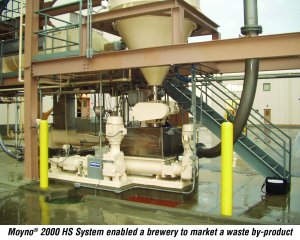Turning a Costly Waste stream into a Profit Stream
Quality and cost can be the pride or demise of any brewery. Companies need to maintain the perfect balance without risking either aspect. A major North American brewer recently sought an improved process for transferring dry grain dust. In the process of manufacturing, streams of raw materials are ...

... transformed and combined into a final product stream that generates profit for the company. Salvaging the usable dust by reworking it in with another by-product seemed like a feasible option. The brewery did not want to recycle the dust due to quality concerns with the company’s primary product, beer.
In the process, not all transformations are completely efficient and by-products are produced and have to be utilized or disposed. Most by-products end up being a waste stream from the process and there is typically a cost associated with its proper disposal. It is every manufacturer’s dream to transform a costly waste stream into a profit stream by transforming a by-product into a marketable secondary product. With a Moyno High Solids Pumping System, the American brewer was able to achieve this goal.
The Situation
In the brewing process of beer, dry hops and grains are injected into the brew tanks. During this transfer, a significant amount of dust is created. Each brew tank is ventilated, and the ventilation system exhausts through a bag filter to capture the air-borne solids. With the large production rate of beer, a significant amount of dust is created over time and has to be disposed.
The brewer stored the grain dust in a silo and was paying a significant amount for loading trucks to take the solids to a landfill. Filling the trucks from the silos again created a significant amount of dust. Since there was no ventilation system on this part of the process, grain dust was spewed everywhere. In addition, handling the dry grain dust is an explosion hazard. In order to convert the dust into waste product easier to move, the brewer attempted to wet down the dust solids to minimize the spread of the dust. The brewer’s positive displacement pump technology required excessive amounts of water to get the solids to pump. Since freight cost is based on weight, it become very expensive to ship the excessive water. Another solution was needed to handle this dust by-product.
The Solution
The best options were to try to re-use the grain dust in the brewing process, or convert the dry dust to a saleable by-product. Since the dust was comprised of solids from multiple grains, there was no way to control the amount of dust from each grain type. This inconsistency is a concern for the taste of the final brew, and reworking the dust back into the process was a quality control issue. Spent Grain is the main by-product of the brewing process that has a saleable market as animal feed. Spent Grain is the moist solids from the cooked grains after the brewing process. If the dust could be slightly moistened to the right consistency, it could be metered into the spent grain stream which would allow the dust solids to be sold for a profit. The moistened dust would also diminish its explosive nature. Mixing the grain dust solids into the spent grain was the best option.
The brewery needed a viable option to take the dry dust solids from the silo, economically convert it into a viscous paste, and then combine it at a low ratio with the spent grain stream located 70 feet away. The brewery engineers knew the current pump technology was not feasible and decided to try the Moyno® 2000HS - High Solids Pumping System.
The major North American brewer needed a robust and reliable pump that could operate at the appropriate pressures. The Moyno® HS system proved to be a viable solution to pump the highly viscous grain paste. The pump was sized to generate the needed flow and pressure to meter the paste inline with the wet spent grain.
The Moyno 2000 HS System features an integral twin-screw auger feeder and specially designed progressing cavity pump that efficiently handles high solids, semi-dry material. The self-cleaning twin-screw feeder easily provided a constant, pressurized feed rate into the Moyno® G4 Progressing Cavity Pump elements which provided a steady, non-pulsing flow for significantly lower operating pressures. The resulting 100 percent pump cavity fill rate enhances overall system performance and cost efficiency. The twin-screw feeder also eliminates the need for a feed pump or extended augers common to lengthy, competitive, open-throat progressing cavity pumps.
Most positive displacement pump companies claim they can pump a product as long as they can get it into the elements. Since the only thing a pump element can do is pull a vacuum, atmospheric pressure is required to push the product into the pump elements. The maximum benefit of atmosphere is 14.7 PSI minus the Net Positive Suction Head Required (NPSHR) of the pump. This available inlet pressure is extremely limited considering super viscous materials have high line losses and there are numerous unknowns in trying to predict if a product will bridge or rat hole. As this brewer saw with the current positive displacement technology, atmospheric pressure alone is not enough to get the material into the pump; they needed to water the solids down significantly. Due to the limitations on the suction side of the pump, innovative and sophisticated means are needed to get non-flowable products into the pump elements.
The Moyno TSF has a wide surge zone and a pressure tube section that is capable of generating a positive stuffing pressure. Depending on viscosity, the TSF can generate up to 30 PSI stuffing pressure into the G4 pump elements. The suction side of the Moyno G4 pump is specially designed for high viscosity. The pump inlet has a wide sweep radius, as well the pump’s universal joint is located outside the flow path of the product allowing for an unobstructed feed into the element. The rotor has a patented auger to give the viscous product a final boost into the elements.
The significant stuffing pressure of the TSF and the G4 inlet design provides excellent fill efficiencies to the pump elements on viscous, non-flowable products. The Moyno G4 pump is designed with the proper stages to generate the required discharge pressure, up to 1000 PSI, to move the viscous material through the discharge piping. The flexibility in geometry of the twin screw feeder and the Moyno progressive cavity pumping principle allows the pump system to be easily modified. This flexibility allows the Moyno 2000 HS pump system to be designed to fit any application, instead of trying to force the application to fit the pump.
The twin-screw feeder length and hopper size offered considerable flexibility for surge capacity. Since the auger screws worked in an intermeshing action, the brewer considered whether the twin-screw feeder could also be used as a mixer, thereby saving large capital requirements for a high viscosity mixing tank.
The Moyno 2000 HS system was set up as a batch type sequence. Water was injected through multiple spray nozzles into the twin-screw feeder. The dry solids grain dust was added to the twin-screw feeder hopper at a controlled speed through on a rotary valve.
By running the twin-screw feeder of the 2000 HS system in reverse, the intermeshing augers continuously rolled the solids over and over thereby effectively mixing the solids with the controlled amount of water. To automate the system, feeder RPM’s and drive torque were monitored. Solids or water were added to the mixture until a set torque was achieved, indicating the paste had sufficient consistency.
After mixing, the directional rotation of the twin-screw feeder was reversed and it began stuffing the viscous paste into the suction housing of the pump. A pressure sensor at the inlet of the pump sensed the stuffing pressure. Once the suction pressure achieved the set point, the pump was energized and the grain dust paste was metered into the spent grain stream.
During operation, the twin-screw feeder speed could also be controlled off the suction pressure sensor to maintain a constant and positive stuffing pressure. A level sensor monitored the twin-screw feeder hopper fill level as the twin-screw feeder hopper was pumped down to low level. The augers were then reversed; water and solids were added for the next batch. Typical batch cycle time was less than twenty minutes.
The Conclusion
After start –up, Moyno upgraded the twin screw feeder shafts from packing to mechanical seals to better handle the light viscosity during the initial water phase of the batch sequence. Except for this conversion, the system has been in operation for two years with no spare parts used. The brewer estimated the pay back period for the project was approximately seven-nine months.
Moyno developed the 2000 HS System due to limitations of the traditional single auger, open throat and bridge breaker type of progressing cavity (PC) pumps. The single auger traditional PC pumps have an eccentric orbit to the auger and require considerable clearances on the sidewall. Various single auger options, such as large ribbon type augers, have been tried by different manufacturers, but the open clearances are apparent. These single auger designs simply cannot generate a significant and positive stuffing pressure into the pump elements needed for the higher viscosity products. In addition, the pump’s universal joint is located at the inlet of the element causing the viscous product to flow around it. This obstruction by the joint is difficult for a viscous product to flow around when no real feed pressure is available. The 2000 HS has allowed Moyno to overcome these limitations of the traditional single auger PC pump to effectively pump a higher level of viscous non-flowable products.
With the various Ultra-Feed™ solutions, Moyno has developed the widest product offering in terms of efficient feed enhancement to handle multiple ranges of viscosity or solids, thereby offering any processor the most competitively priced, effective pumping solution from a single manufacturer. The Ultra-Feed™ technologies have definitely gained Moyno the reputation as the viscous product / high solids expert in the pump industry.
The Moyno 2000HS System offered the reliability in high solids pumping needed by the brewer. Not only was the brewer able to find a practical, effective solution for its dry grain dust issue, but the customer turned a costly waste into a revenue stream. The enhanced design of the Ultra-Feed™ pump rotor further contributes to superior volumetric efficiency. Industry standard VFD controls are clean, quiet and efficient, while a load cell electronic weight control system ensures accurate mass flow rate measurement. For moving high solids content, the Moyno® 2000 HS System is the cost-effective alternative to expensive, high-maintenance piston pumps, conveyors and other types of positive displacement pumps.
Source: Moyno







